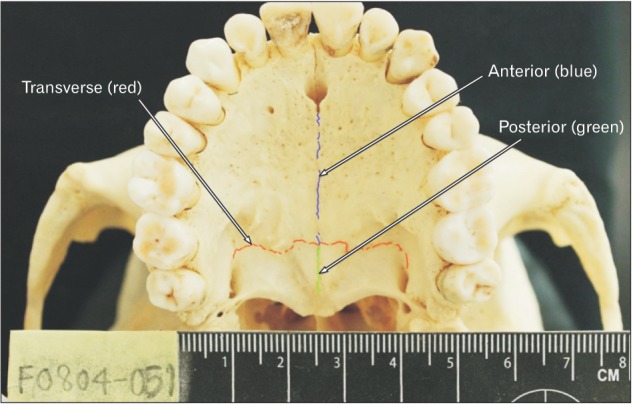Anat Cell Biol.
2017 Dec;50(4):261-264. 10.5115/acb.2017.50.4.261.
A new method for sex estimation from maxillary suture length in a Thai population
- Affiliations
-
- 1Forensic Osteology Research Center, Faculty of Medicine, Chiang Mai University, Chiang Mai, Thailand. pasuk034@gmail.com
- 2Excellence in Osteology Research and Training Center (ORTC), Chiang Mai University, Chiang Mai, Thailand.
- 3Department of Anatomy, Faculty of Medicine, Chiang Mai University, Chiang Mai, Thailand.
- 4Department of Anatomy, Universiti Kebangsaan Malaysia Medical Centre, Kuala Lumpur, Malaysia.
- KMID: 2399894
- DOI: http://doi.org/10.5115/acb.2017.50.4.261
Abstract
- Sex estimation is one of the crucial procedures in the biological profile identification of human skeletal remains. Knowing sex of unknown case can lead to accurate and appropriate methods for predicting age, stature, ancestry, or even personal identification. Skull is one of the most reliable one among other skeletons and it is usually retained for both archaeological and forensic contexts. Although many morphological features and metric measurements of skull have been studied for sexing, but to the best of our knowledge is no study on maxillary suture length for sex estimation. Therefore, this study aims to develop a new sex estimation method for a Thai population by determining three maxillary suture lengths: anterior, transverse, and posterior maxillary suture, by computerizing amount of pixel obtained from photographs of these sutures. The present study was conducted on 190 Thai bone samples of which 96 were males and 94 were females. Independent t test revealed statistically significant difference (P < 0.01) between males and females in all maxillary suture measurements. Equations derived from prediction model, which required three maxillary suture lengths gave 76.8421% accuracy from the leave-one-out cross validation in estimating sex percentage accuracies in predicting sex from these equations, which were relatively moderate. This study provides a novel and objective sex estimation method for Thais. It suggests that maxillary suture length can be applied for sex estimation. The new computerized technique will contribute basis knowledge and method for sex estimation, especially when only base of skull is available in forensic circumstance.
MeSH Terms
Figure
Reference
-
1. DiGangi EA, Moore MK. Research methods in human skeletal biology. Oxford: Elsevier;2013.2. Mays S, Cox M. Sex determination in skeleton remains. In : Cox M, Mays S, editors. Human Osteology in Archaeology and Forensic Science. London: Cambridge University Press;2000. p. 117–130.3. Macaluso PJ Jr. Metric sex determination from the basal region of the occipital bone in a documented French sample. Bull Mem Soc Anthropol Paris. 2011; 23:19–26.4. Kamath V, Asif M, Shetty R, Avadhani R. Binary logistic regression analysis of hard palate dimensions for sexing human crania. Anat Cell Biol. 2016; 49:151–159. PMID: 27382518.5. Wood JK. Direction and type of the transverse palatine suture and its relation to the form of the hard palate. Am J Phys Anthropol. 1949; 7:385–399. PMID: 15392784.6. Mann RW, Symes SA, Bass WM. Maxillary suture obliteration: aging the human skeleton based on intact or fragmentary maxilla. J Forensic Sci. 1987; 32:148–157. PMID: 3819673.7. Suazo GI, Zavando MD, Smith RL. Accuracy of palate shape as sex indicator in human skull with maxillary teeth loss. Int J Morphol. 2008; 26:989–993.8. Suazo GI, Zavando MD, Smith RL. Performance evaluation as a diagnostic test for traditional methods for forensic identification of sex. Int J Morphol. 2009; 27:381–386.9. Nascimento Correia Lima N, Fortes de Oliveira O, Sassi C, Picapedra A, Francesquini L Jr, Daruge E Jr. Sex determination by linear measurements of palatal bones and skull base. J Forensic Odontostomatol. 2012; 30:38–44. PMID: 23000810.10. Sumati PV, Phatak A. Determination of sex from hard palate by discriminant function analysis. Int J Basic Appl Med Sci. 2012; 2:243–251.11. Skrzat J, Holiat D, Walocha J. A morphometrical study of the human palatine sutures. Folia Morphol (Warsz). 2003; 62:123–127. PMID: 12866672.12. Mann RW, Jantz RL, Bass WM, Willey PS. Maxillary suture obliteration: a visual method for estimating skeletal age. J Forensic Sci. 1991; 36:781–791. PMID: 1856646.13. Beauthier JP, Lefevre P, Meunier M, Orban R, Polet C, Werquin JP, Quatrehomme G. Palatine sutures as age indicator: a controlled study in the elderly. J Forensic Sci. 2010; 55:153–158. PMID: 20002267.14. Apostolidou C, Eleminiadis I, Koletsa T, Natsis K, Dalampiras S, Psaroulis D, Apostolidis S, Psifidis A, Tsikaras P, Njau SN. Application of the maxillary suture obliteration method for estimating age at death in Greek population. Open Forensic Sci J. 2011; 4:15–19.
- Full Text Links
- Actions
-
Cited
- CITED
-
- Close
- Share
- Similar articles
-
- Sex estimation from upper limb bones in a Thai population
- Stature estimation using the sternum in a Thai population
- Sex estimation using radius in a Thai population
- Age estimation equations using vertebral osteophyte formation in a Thai population: comparison and modified osteophyte scoring method
- An experimental study on gross reactions of surrounding maxillary sutures to the widening of midpalatal suture in the dog


